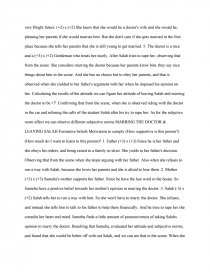The Empty Pillow
Essay by review • August 27, 2010 • Essay • 1,642 Words (7 Pages) • 1,833 Views
Using the theory of reason action-Fishbein and applying it on a 5 min. scene of the movie by: AlomaniQ8 THE EMPTY PILLOW This is a love story that it's events occur, in Egypt, in the fifties, where there were strict traditions about love between non married lovers, and where the word of the parents rules the lives of their sons and daughters. In that movie, a young man (salah) who is still a student falls in love with a beautiful girl (Sameha), whom she is also an eighteen years old student, they are both college students, that get supported by their families. The scene begins, when Salah asks his father that he wants to be married, but his father laughs, and asks him if he is able to support himself or her. Salah's father suggested that he should wait until he graduates and gets a job, so he could marry her. Salah refuses, saying that she would get married to someone else, and her parents will not wait for me until I graduate. Unfortunately a doctor proposes to her and asks her hand to be his wife. Sameha's father and mother agree instantly, without giving Sameha any notice, only thinking of the position and the how they would guarantee a wonderful future for their daughter with this doctor, adding that he is a very nice man and have great reputation. Sameha says that she is young to be married, and disagree. Sameha's father say's "no doughtier of mine argues with me in such matters, you will do as I say" Consequently, Sameha stop arguing. And shows yielding. She think about the hard time choosing between the two, the one she loves! or the fine rich physician, which her parents ergs her to marry. In order to prevent the marriage, Salah meets her in the desert where they used to meet. He starts convincing her to run a way with him. Sameha refuses, saying that her parents might have a heart attack, then she will not forgive herself. Salah remembers, what one of his friends suggested to him, and that he should rape her, and in this way she would be his according to the traditions. Consequently he tries to do so. She cries and begs him to let her go. But he refuses, until he notices the ring that she is still wearing, which he brought to her as a token of their love. Sameha runs a way. Sameha thinks hard and consults her heart and mind. Salah calls her but she refuses to answer. The next scene she is observed in a nice car with the doctor. The doctor opens the car door for her. The next week she gets married to the doctor. Other events happen in the next scenes where Salah graduates and get a job, making great success in his curare as a businessman. Salah marries the daughter of his boss. Salah invites Sameha and her husband (the doctor), so she sees the position that he got and the beautiful wife that he is marring, thinking that Samaha would be jealous and regret that she did not wait to marry him. But Sameha congratulates him and showing that she is happy with her choice to marry the doctor. Using the Theory of Reason Action-FISHBEIN. Fishbein refers to beliefs, attitudes, and intentions. We have referred to these as the cognitive, affective, and cognitive (behavioral) components of attitudes. In this theory, the receiver's variables such as the demographic: age, sex, education, religion and the personality have a direct impact on beliefs and how they are evaluated. The behavior is a function of the individual's behavioral intention. Intentions are compromised of two components. 1. Affective attitudes, which are a function of beliefs about consequences subjective Evaluation of those consequences. 2.Subjective norms, which are a function of beliefs about the expectations of others times my motivation to comply with them. Behavioral intentions are the only direct determinant of behavior. And are determined by affective attitudes and subjective norms. The personal component: Belief: How true is it about the attitude object? Evaluative: Hoe good or bad is it? Social component Normative beliefs: How supportive is the person? Motivation to comply: how much do I want to listen to this person? The research study: In the text, page (108-112) we see the example of buying a new car. We have two consumers A and B. Both of the consumers are placed in an equal weight on the attitude and the subjective norm components. For consumer A, a calculated attitudes by adding the multiplying attitudes to evaluate the belief by considering the consequences of buying a new car, such as better gas mileage, prestige less money in bank, and higher insurance premiums. We notice the sum of belief evaluation tends to be in the positive +8, while consumer B belief evaluation of his attitude tends to be in the negative -6 consequently we say that consumer a has high a positive attitude towards buying a new car, while consumer B has a negative attitude towards buying a new car according to their money in the bank, which wouldn't allow them to buy the car. As for their normative belief (motivation to comply), the subjective norms are measured based on the important referent such as, spouse's, father's, neighbor's, and child's opinions and would they agree on buying a new car. Again the subjective norms are ca! lculated, resulting the same results as the attitude evaluating, as having positive for consumer A and a negative for consumer B. Concluding the behavioral intentions of the two consumers towards buying a new car. Hence consumer A has positive results the attention is to buy a new car is positive. And
...
...




